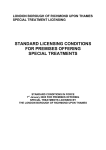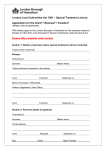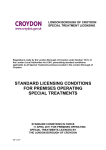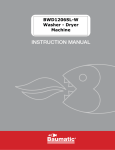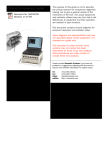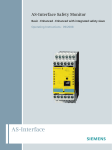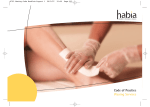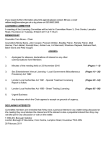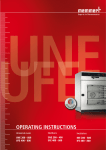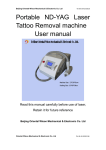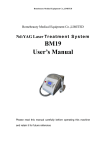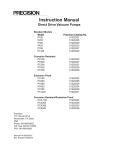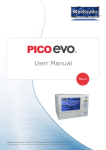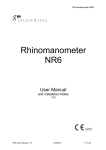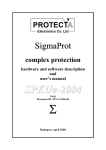Download Standard Conditions 2015-2016
Transcript
STANDARD CONDITIONS THESE STANDARD TERMS AND CONDITIONS ARE IN FORCE FROM 1 April 2015 - 31st March 2016 FOR PREMISES OFFERING SPECIAL TREATMENTS LICENSED BY THE LONDON BOROUGH OF HOUNSLOW Regulations made by the London Borough of Hounslow under Section 10 (1) of the London Local Authorities Act 1991, prescribing the Standard Terms and Conditions applicable to all Special Treatment premises located in the London Borough of Hounslow. The terms and conditions that apply to a Special Treatment Licence will remain under review and when required will be amended. Amendments will generally be introduced in the following licensing year Unless there are circumstances where we need to make the change without delay to ensure that equipment used or new treatments and or practices applied is prevented from putting a person at risk to their health, safety and wellbeing. If this situation were to arise you will be informed of any required changes to your licensable treatments. Date of Review: 1st March 2015 Standard Terms and Conditions For Premises Offering Special Treatments CONTENTS Introduction Notes and Requirements made on the Licensee PART 1 – General 1) Definitions 2) Dispensation/modification of rules PART II – Conditions Applicable to all Premises TOPIC 1) The Licence 2 & 3 ) Responsibility of the Licensee 4) Charge of Licensed premises 5) Conduct of the Premises 6) Qualifications & Training 7) Tattooing & Body Piercing 8) Authorised Officers 9) People with Disabilities 10) Electricity &Gas Installations Examination Reports & Maintenance 11) Personal Hygiene 12) Refuse 13) Record Keeping 14) General Maintenance 15) Anaesthetic 16) Control of Substances Hazardous to Health (as amended) 17) Aftercare 18) First Aid 19) Language 20) Emergency Assistance Device Page No 3 3-4 4 5 5 6 6 6 6 7 7 7 7 7 8 8 8 8 8 PART III - Additional Conditions for Specific Treatments 1) Sauna 2) Heated Spa Baths 3) Floatation Tank 4) Electrolysis 8–9 9 9 9 5) Ultra Violet Tanning Equipment 6) Semi Permanent Make Up/Micro-pigmentation 7) Tattooing 8) Body Piercing 9) Manicure – Pedicure & Artificial Nails 10) Non-Surgical Lasers/IPL 11) Laser / IPL Controlled Area 12) Laser Protection Supervisor 11 - 12 10 12-13 13-15 15 - 16 16 -17 17 18 Date of Review: 1st March 2015 PART IV – Application Forms for Specific Treatments 1) 2) 3) 4) 5) S.T.A.R./1 (Special Treatments Annual Renewal) S.T.A.N./2 (Special Treatments New Application) Therapist & Apprentice Registration & Guidance Self-Employed Registration & Guidance Fast Track Registration & Guidance 19 - 20 21 - 28 29 - 31 32 33 - 34 List of Appendices Appendix Page No Appendix A – Certificates to be held at Licensed Premises 35 Appendix B – Sample Consent Form 36 Appendix C – Laser / IPLS Treatment Protocol Document 37 Appendix D – Content of Laser / IPLS Local Rules Document 38 – 40 Appendix E – Ultrasonic Cleaning Procedure and Verification Tests 41 – 42 Appendix F – Non Vacuum Sterilising Procedure & Verification Tests 43 – 44 Appendix G – Vacuum Sterilising Procedure & Verification Tests 45 – 46 Appendix H – Infection Control Pro-forma 47 Date of Review: 1st March 2015 STANDARD TERMS AND CONDITIONS FOR PREMISES OFFERING SPECIAL TREATMENT Revised conditions for premises licensed by the London Borough of Hounslow in force as from 1 April 2015. Introduction These Standard Terms and Conditions are applicable to all premises, including private residential premises offering special treatments. The application does not in any way however, replace or reduce the underlying statutory duty of employers and self-employed persons to comply with the requirements of the Health and Safety at Work etc Act 1974 and any associated regulations and codes of practice which may be applicable to these premises. Fee Charges The price for a Special Treatment License is reviewed annually. There are No Exemptions made within this pricing structure, irrespective of the status of the business operation or any hours the business or individual may work. A table of Fees identifies the cost of each licensable treatment. The license fee required from the applicant is based on the ‘Highest’ treatment category. All other licensed treatments will be included in this one price . Note: Fees paid for a ‘Licence’ or ‘Therapist’ registration in another authority has no standing in the London Borough of Hounslow. The issue of a Therapist / Apprentice registration from the Council is not transferrable to any other business offering licensable treatments in the London Borough of Hounslow. These fee charges include: Treatments carried out in the 4 categories Therapist / Apprentice registration Fast Track Registration (annual subscription) Licence variation Declined payment Cancellation payment Self-Employed Registration (applicable only when the ‘Person’ becomes a separate applicant for a licence when wishing to operate at an already existing licensed premises - see requirements for applying for a license and for a therapist registration). If during the year of your licence you cease trading then you may apply for a ‘Refund’ which if agreed by the Council will be calculated on deduction basis which will be: ‘time of licensed activity deducted from the Full Licence fee.’ The licensee must in writing apply to the Health & Safety Licensing (Special treatments) Team requesting a refund and give reasons why a refund should be made b y the Council. There will be an administration charge of £30 deducted from the original payment made by the applicant where the applicant wishes to cancel their application and the application has already been processed. Date of Review: 1st March 2015 1 Health & Safety Licensing Visits To ensure that the Standards Terms and Conditions are being met by the ‘Licensee’ we will conduct visits to establish that you are in compliance with your licence. It is not necessary for us to visit each licensed business every year. If we do intend to visit your business we will contact you to arrange a suitable date and time to meet you as the licensee / manager. Alternatively you can contact us to arrange a visit where we can provide advice and guidance on your treatments / health and safety. The exception to pre-booking visits is that due to complaints we may receive or as part of any project work we are undertaking in the beauty industry we may call at your premises without first contacting you. Part 1 - GENERAL Definitions In these rules, unless the context otherwise requires:Act means Part II of the London Local Authorities Act 1991 (as amended). Approval of the Council or Consent of the Council means the written approval or consent of the Council as Licensing Authority in writing. Approved, Accepted or Permitted means approved, accepted or permitted by the Council in writing. Council means the London Borough of Hounslow. Special Treatment means nail treatments, massage, electric treatments, light treatments, water treatments, skin piercing, tattooing and other treatments of a like kind. Establishment for Special Treatment has the meaning set out in section 4 of the London Local Authorities Act 1991 (as amended). Fire Authority means the Chief Officer and Chief Executive of the London Fire and Emergency Planning Authority. Licence Holder/Authorised Person means a person who is responsible for compliance with the standard conditions at all times that the premises are open for business. Licence means a special treatment licence granted under section 6 of the London Local Authorities Act 1991 (as amended). Premises means any premise within the Council’s area licensed for special treatments and includes all installations, fittings etc. Therapist, Practioneer, Beautician or Operative means – the person carrying out any special treatments at the licensed premises and who has been authorised by the Council and whose name is listed on the Special Treatment Licence. Authorised Officer means an Officer appointed by the Council. Date of Review: 1st March 2015 2 Dispensation or Modification of Rules These rules may be dispensed with or modified by the Council in any special case. In accordance with the provision of paragraph 10 of the London Local Authorities Act 1991, the Council may, in granting a licence or giving any written approval or consent under these rules, impose such terms, conditions, or restrictions as it shall specify in writing. If the licensee who wishes to have any of the Standard Terms and Conditions of his./ her licence to be varied, he / she must make an application to the Council, and if the Council so requires, the application must be advertised at the licensed premises. PART II - Conditions applicable to all premises 1) The Licence The current licence or a clear copy shall at all times be prominently exhibited at the premises in a position where it can easily be read by patrons. The licence is personal to its holder. The licence cannot be transferred to any other person unless the procedure prescribed in the Act has been followed, and the Council has granted the application. The licence is only valid in respect of the premises named on the licence. A licence will include the names of individual operatives approved by the Council. Licences are granted for a maximum period of twelve months. This being period from the 1st April - 31st March of the following year. Or from the date of application ending on the 31st March. A licence will be issued in the name of the applicant and, for the purposes specified in Condition 2. Note If it is found during or after an application has been processed by this department that the ‘Declaration’ made and signed by the applicant is known to be ‘Untrue’ by the applicant the application shall be refused or where a licence has already been granted it shall become void. 2) Responsibility of the Licence Holder/Authorised Person • the licensee holder / authorised person is directly responsible for reading the terms and conditions that are attached to the granted licence and the need to ensure that these are complied with. • may authorise a responsible person to be in charge of the premises during opening hours. • shall take all reasonable precautions for the safety of all persons using the premises and ensure compliance at all times with the relevant provisions of the Health and Safety at Work etc Act 1974, and other associated legislation. • shall be in charge of the premises at all times. • shall take out employer’s liability (where applicable) and public liability insurance cover to the minimum value of £2,000,000 • shall ensure that all operatives carrying out ‘special treatments’ are suitably trained/qualified and evidence of such shall be submitted to the Council for approval. • shall ensure that complete and proper records are maintained of ALL treatments provided and a record made of the person providing the treatment. • shall make available on request a copy of a current floor plan of the premises. 3 Date of Review: 1st March 2015 3) It is the responsibility of the Licensee to ensure the following: • • • • • • • • • • • Trainee/Apprentices shall appear on the licence named as such. no other person other than those named on the licence are permitted to carry out any licensable treatments. shall ensure that no nuisance arises from the business, e.g. odours, noise etc. shall ensure that at least one operative present in the premises on a day to day basis carrying out special treatments is required to have an understanding of spoken and written English in order to satisfactorily discuss client records and aftercare advice. shall be responsible for maintaining a fire risk assessment to include proper precautions against fire, the maintenance and proper order of means of escape in case of fire, and the means of fighting fire at the premises. shall clearly display a tariff of all special treatments provided. Suitable heating, lighting and ventilation are required in all areas of the premises and this shall be maintained in a suitable and safe conditions. An accessible wash hand basin shall be fitted within the treatment area and provided with hot and cold running water, preferably by mixer taps and nonhand operated taps. Sanitising soap dispensary and disposable paper towels shall provided. A suitable equipped first aid kit shall be readily accessible at the premises. Supply of drinking water shall be provided for public use, close to the treatment areas. Where treatments are provided that will result in a person being in a state of undress then ‘Privacy’ shall be an essential part of the treatment process. You are required to ensure that adequate measures are put into place to prevent ‘Others’ inadvertently gaining sight of any person in the treatment area. The screening of the area must be by way of a room which has a door that can be closed during treatment. The door to the room must be accessible in a case of emergency from the outside, therefore the system of locking the door should be one that can be opened externally e.g. slot turn to the door handle. Curtains that open out into a common area where people will pass or gain view to the room from when in the area will not be accepted. 4) Charge of Licensed Premises The licence holder/authorised person are directly and solely responsible for making themselves familiar with all the Standard Terms and Conditions applicable to their licence. If any breaches of the said Standard Terms and Conditions are found by the Council, the Council may if required initiate formal proceedings to be taken against the Licensee. This includes any deputisation passed onto another person who manages the premises on their behalf. The licence holder shall ensure that all persons carrying out special treatments, whether an employee or as a self-employed person allowed by them to provide licensable treatments in the licensed premises are informed of the requirements made in the Standard Terms and Conditions of their licence. The licence holder will remain responsible for compliance with the Standard Terms and Conditions of their licence including any time where they may not be in the country. Date of Review: 1st March 2015 4 5) Conduct of the Premises No poster, advertisement etc shall be displayed which is unsuitable for general exhibition. The licence holder/authorised person shall ensure that no part of the premises is used by persons, for soliciting or other immoral purposes. The licence holder / authorised person shall not without first making an application to the Council for its permission make use of any part of the premises whether existing or newly constructed for the purposes for providing treatments, if it was not submitted on the original application / plan given to the Council for consideration. 6) Qualifications & Training All persons carrying out special treatments shall have received suitable training in the treatments being undertaken and also use of any relevant equipment. Written evidence of all training shall be made available to an officer on request either at a visit or subsequently through letter requiring the information required. Please NOTE that you should check to see if your qualification/s or of ANY therapist you wish to engage have been issued from a ‘Training Body / Establishment’ listed in our Training Establishment List who Offer NVQ’s, SVQ’s, VTCT, City & Guilds etc. in Beauty Treatments. If the qualification is not from one of these organisations then the therapist application is likely to be refused unless you or they are able to provide further sufficient evidence to support what was involved in your training. This will include the syllabus, modules taken, examination / evaluation process and if the body / organisation is able to demonstrate they have an effective monitoring system / disciplinary procedures to ensure that standards of qualification and professional competency of candidates is maintained. We will not accept just the production of a Certificate, Diploma or Degree provided by an applicant without the support of references stated above, including the UNITS they undertook as part of the qualification award they received. The list of the Accredited Training Establishments offering qualifications in Beauty Treatments is available on request. ALL persons wishing to apply to provide Special Treatments or who wish to become an apprentice at the licensed premises must complete fully the Therapist / Apprentice Registration Form (T&ARF). If an application to provide licensable treatments or become an apprentice is made on the Special Treatment Application Form (S.TA.N./ 2) without the completion of the (T&ARF) then the application will not be processed and the ‘individual shall be informed of the decision. Date of Review: 1st March 2015 5 7) Tattooing & Body Piercing When the Licensee wishes to take on a new Tattooists & Body Piercer or Apprentice you must complete the (T&ARF) and include on the continuation sheet details of where the proposed, if already recognised as a Tattooist / Body Piercer last worked including all relevant contact details (see – self-employed registration form for guidance ) or if to be engaged as an apprentice the name(s) of the person who will b e providing the training to the apprentice. Where a person is to be engaged as an ‘Apprentice / Trainee’ they should not be allowed at any time to provide a treatment unsupervised. Supervision can only be managed by a therapist who is licensed by this authority to provide Tattooing or Body Piercing. No Person shall provide any treatment irrespective of any financial reward being received without this approval. When a new Tattooist / Body Piercer is applied to the Council to be registered the Council will carry out reference checks on that person references. If no evidence can be provided by the licensee or of by the referee(s) named by that person to the Council fail to show that the therapist has the necessary, knowledge, skills or qualification then the application will be refused. 8) Authorised Officers Authorised officers, on presentation of their written authorisations and proof of identity shall be admitted at all reasonable times to all parts of the premises. It is an offence to prevent an ‘Appointed’ officer of the Council from carrying out their duties. 9) People with Disabilities It is the policy of the Council that access for disabled people should be provided at business premises licensed for special treatment. Licensees are, therefore strongly encouraged to provide such facilities so as to enable the admission of disabled people and are reminded of the duties imposed by the Equalities Act 2010. 10 Electricity & Gas Installations Examination Reports & Maintenance All electrical equipment used should be maintained in a safe working condition. You are advised to seek further guidance on any scheme of maintenance that may be required from a qualified and competent electrical contractor, whose name is on the roll of the National Inspection Council for Electrical Installation Contracting (N.I.C.E.I.C). A valid signed document/certificate by the person carrying out the examination must accompany this application, if this is your first application to be licensed. You remain responsible for ensuring that after the period your current certificate expires that you have any subsequent examinations as required are carried out. Where a ‘Gas’ examination is annually required (e.g. boiler system) you may be required to produce the current gas safety certificate. You must have any required examinations carried out by an approved ‘Gas Safe Engineer.’ They will provide you with a valid signed certificate / document of the examination. All other equipment used within the Standard Terms and Conditions of your licence must be maintained in a safe working order and condition to the satisfaction of the Council. Date of Review: 1st March 2015 6 11) Personal Hygiene Any person carrying out any special treatment must ensure that: • any open boil, sore, cut or other open wound is effectively covered by an impermeable dressing. • hands are kept clean and are washed immediately prior to carrying out any treatment. • they refrain from consuming food and drink during the course of the treatment. • No animals are permitted in the treatment rooms at any time except for guide dogs. 12) Refuse Under the Controlled Waste Regulations 1992 and the Environmental Protection Act 1990 operatives/licence holders have a duty of care to ensure that all clinical waste i.e. used dressings, swabs etc (infected or not) and used needles are collected and disposed of by a licensed contractor. A waste transfer document shall be available at the premises for inspection. The clinical waste bags shall be yellow and marked as ‘Biohazard – clinical waste’ and whilst awaiting collection should be stored in a secure area. 13) Record Keeping The licensee MUST maintain and make available to an ‘Officer’ at his /her request copies of their clients records. Client records for all treatments of category 3 & above must be kept for 3 years & for category 4 for a period of 12 months Any ‘Contra–Indications’ e.g. Heart conditions, Diabetes, Epilepsy etc. for each treatment will be discussed with the client prior to any treatment, and the client shall sign a record card to say that they have been made aware of the risks involved. This must also be kept on file for a period of 3 years. 14) General Maintenance All systems i.e. fire safety equipment, boilers; etc provided in the premises shall be maintained / serviced regularly by competent persons and records available on site for inspection. All equipment used in connection with special treatments shall be serviced/ maintained in accordance with the manufacturers/suppliers recommendation, and records kept. Bench top sterilisers shall be calibrated and maintained in accordance with the Manufacturers recommendations and records available on site. 15) Anaesthetic Administration of local anaesthetic injections other than by medically qualified practitioners is an offence. Under the Medicines Act 1968, local anaesthetic creams, sprays, gels etc. are prescription only medicines and pharmacy medicines which may only be sold by pharmacists for medical application on the patient only. Their use prior to a body piercing is therefore an offence. Date of Review: 1st March 2015 7 16) Control of Substances Hazardous to Health Regulations 2002 (as amended Substances which fall under the above Regulations e.g. Barbicide, bleach, nail monomers etc shall be assessed in accordance with the requirements of those Regulations and all the necessary precautions taken to ensure their safe use and storage. The safety data sheets for all products used in connection with the business, shall be available at the premises. 17) Aftercare Each client shall be provided with verbal and written aftercare advice for each treatment they receive, and confirmation of this should be recorded on their client record card. You are advise to ask the ‘Client’ to sign for receipt of this advice. 18) First Aid It is recommended that one person working in the premises is trained in basic first aid techniques in accordance with the First Aid at Work Regulations 2010. A first aid box shall be available in the premises in accordance with the First Aid at Work Regulations 2010. 19) Language All therapists must have the ability to be able to sufficiently communicate with a ‘Client’ verbally and in written English in order to satisfactorily provide the following: 1) hold a consultation, 2) provide aftercare advice, 3) maintain client records, 20) Emergency Assistance Device All special treatment equipment e.g. tanning beds, sauna’s spa’s shall have fitted either on or close by to the equipment a device to summon assistance in an emergency. The device shall be connected to a staffed area. PART III - Additional conditions for specific treatments 1) Sauna • • • • • • • • No persons under the age of 16 shall be permitted to use the sauna. A thermometer shall be provided indicating the temperature inside the sauna. An emergency button shall be provided on the sauna, which is connected to a reception or other staffed area. A clock or timer shall be visible to users, from inside the sauna. The temperature control device shall not be accessible to users of the sauna. The hot coals in the sauna shall be protected by a guard rail or barrier. Shower facilities shall be provided close to the sauna. A supply of fresh drinking water shall be available close to the sauna. Date of Review: 1st March 2015 8 The following Safety guidelines on the use of the sauna shall be displayed nearby. No person under 16 shall not use the sauna . All jewellery to be removed Drink plenty of water before using the sauna No eating or drinking in the sauna Avoid use if suffering from high blood pressure or heart problems Do not eat immediately before using the sauna Maximum time spent in sauna 15-20 minutes Drink plenty of water after use 2) Heated Spa Baths • • • • • • • • No persons under the age of 16 shall be permitted to use the spa baths. The spa water shall be suitably treated to prevent the growth of legionella bacteria by means of automatic dosing equipment in accordance with the Approved Code of Practice L8 entitled ‘Control of Legionella Bacteria in Water Systems’ produced by the Health and Safety Executive. Water tests shall be carried out at 4 hourly intervals to ascertain the chlorine, pH etc levels of the water. Written records of the results shall be kept on the premises. The spa shall be fitted with an automatic close down device, which operates approx every 15 minutes for a period of 5 minutes. Safety guidelines on the use of the spa shall be displayed nearby. An emergency button shall be provided on the spa, which is connected to a reception or other staffed area. Shower facilities shall be provided close to the spa. A supply of fresh drinking water shall be available close to the spa. The following Safety guidelines on the use of the spa shall be displayed nearby. • No person under 16 shall not use the spa. • Maximum time (recommended) in the spa is 15 minutes • Do not use the spa if you are pregnant. • Do not use the spa if under the influence of drugs, alcohol or medication. • Persons suffering from obesity or with a medical history of heart disease, low or high blood pressure, circulatory system problems should consult a doctor before using the spa. • Persons using medications should consult a doctor before using the spa. • Persons with sores or open wounds should not use the spa. • Take care when entering and exiting the spa. Wet surfaces may be slippery. 3) Floatation Tank • • • Shower facilities shall be provided close by the equipment. A supply of fresh drinking water shall be provided near to the equipment. The water shall be filtered and purified between clients. 4) Electrolysis Individual pre-wrapped sterilised needles shall be used and disposed of as clinical waste after each client. In addition, conditions c) to q) as applying to tattooing (above) shall also apply to electrolysis treatments Date of Review: 1st March 2015 9 5) Ultra Violet Tanning Equipment No persons under the age of 18 shall be permitted to use tanning equipment. 1. Suitable evidence should be requested if there is any doubt concerning age such as: Photographic ID. 2. All persons operating sunbeds shall be suitably trained by the supplier in the operation of the equipment and hold a relevant certificate which shall be kept at the licensed premises. 3. Prior to the use of tanning equipment a record card shall be completed & signed by the user to acknowledge that they have been made aware of and understand the contra-indications associated with ultra violet radiation, particularly with regard to drugs and medical conditions. A record of the frequency of visits shall also be recorded. 4. The length of time that a client uses the tanning equipment shall be controlled by the management and based on the user type of skin, power of the sunbed, and age of the tubes etc. 5. Users of tanning equipment shall have access to an emergency assistance device, which is connected to the reception area. 6. To comply with Conditions 3 (c) and (d) a trained member of staff shall be present at all times at the licensed premises therefore unstaffed tanning premises are prohibited. 7. Each tanning unit shall be fitted with an emergency stop button, which is connected to a reception or other staffed area. 8. All users shall be provided with protective eye equipment free of charge. 9. Arrangements shall be made to ensure that the tanning equipment is cleaned between clients. 10. HSE guidelines IND (G) 209 on UV tanning shall be displayed in each tanning cubicle, copies of this document can be obtained from HSE Website 11. Regular maintenance shall be carried out, to include replacement of tubes. Records of all maintenance visits shall be available at the premises at all times. 12. The HSE recommend a maximum of 20 ultra violet tanning sessions per year, clients shall be advised when they have reached this number and made aware of this recommendation. If the client still wishes to continue with further exposure then their written consent shall be recorded on their client card. Maximum permissible output for all new uv tubes from the 23rd July 2010 is 0.3w/m2. Date of Review: 1st March 2015 10 13.Existing premises shall change all uv tubes to comply with this new standard as and when the tubes are due to be changed as part of the routine maintenance schedule. 14.An emergency assistance device shall be provided on or adjacent to each tanning cubicle, in accordance with Part II . The required level of training to manage or act as the person in control of the use of sunbeds will be at a NVQ level 3 or equivalent qualification. The requirement is not for a full qualification but the achievement of the single unit for this at level 3. In addition to the qualified person any other person engaged to operate and manage the provision of sunbeds for the use of the public must provide sufficient evidence from a ‘Manufacturer / Supplier’ that they have undertaken training with them on the use of that specific sunbed(s) Or Where this exists the person qualified to NVQ Level 3 is responsible form the following: 1) List clear working Instructions, 2) Monitor the employees who have been appointed to operate and supervise the admission of clients for the use of the sunbeds. 6) Semi-permanent make up/micro-pigmentation 1. A consultation with the client shall take place prior to the treatment, during which time a patch test shall be carried out for adverse reactions to the pigments intended to be used, and any contra – indications discussed. 2. Disposable gloves should be worn throughout the procedure these should be non-powdered nitrile or vinyl. They should be disposed of as clinical waste. 3. Under the Controlled Waste Regulations 1992 and the Environmental Protection Act 1990 operatives/licence holders have a duty of care to ensure that all clinical waste i.e. used dressings, swabs etc (infected or not) and used needles are collected and disposed of by a licensed contractor. A waste transfer document shall be available at the premises for inspection. 4. The clinical waste bags shall be yellow and marked as ‘Biohazard – clinical waste’ and whilst awaiting collection should be stored in a secure area. 5. Sharps containers shall comply with the British Standard BS7320 and UN3291 and carry the ‘kitemark’. Sharps containers should be sited above floor level and below shoulder level. 6. Needles and other component parts should where possible be the single use disposable type. These must be disposed of as clinical waste. 7. Re usable instruments should be manually cleaned in the sink before undergoing the ultrasonic process, cleaning should occur below water level rather than under running water. Staff should wear suitable aprons etc during this process if there is a risk of splashing. Date of Review: 1st March 2015 11 8. Following the manual cleaning the instruments should be put through a cycle in an ultrasonic cleaner, the lid should remain closed whilst the machine is in operation. Items should be rinsed thoroughly on completion of the cycle. The detergent solution should be renewed regularly. 9. Instruments should then be sterilised in a bench top autoclave, if using a nonvacuum type then the instruments should be placed UNWRAPPED in the autoclave. On completion of the cycle the instruments should be placed in an airtight plastic container and if not used within 3 hours they must be resterilised. 10. If a vacuum type autoclave is used then instruments should be wrapped/pouched prior to sterilisation. A drying cycle is required to ensure that the pouches etc are not left in a damp condition. The pouches remain sterile for up to 6 months. 11. Autoclaves should be run daily on a test cycle to ensure the machine is working correctly, door seals etc should be checked weekly. The autoclave should be maintained/serviced in accordance with the manufacturer’s recommendations and written evidence should be available on site. A written aftercare leaflet shall be given to each client. 7) Tattooing 1. No tattoo shall be carried out on a client who has not reached their 18th Birthday in accordance with the Tattooing of Minors Act 1969. 2. A tattoo may only be performed by an approved person who is named on the licence, in accordance with Part II 2 (e) of these conditions. 3. All walls, floors, surfaces, seating etc shall be made of washable material. 4. Prior to treatment every client shall read and sign a consent form, which contains details of medical history, name, address, age etc. Photographic proof of age may be requested and details should be entered onto the consent form. 5. An example of consent form is attached in Appendix B. These forms shall be kept on the licensed premises for a period of at least 3 years, and be available for inspection at all times. 6. Under the Controlled Waste Regulations 1992 and the Environmental Protection Act 1990 operatives/licence holders have a duty of care to ensure that all clinical waste i.e. used dressings, swabs etc (infected or not) and used needles are collected and disposed of by a licensed contractor. A waste transfer document shall be available at the premises for inspection. 7. The clinical waste bags shall be yellow and marked as ‘Biohazard – clinical waste’ and whilst awaiting collection should be stored in a secure area. 8. Disposable paper towel shall be used on the couches in the treatment room which shall be changed between clients. Date of Review: 1st March 2015 12 9. All operatives shall wear non sterile, non powdered, low protein latex, vinyl or nitryl gloves. 10. Disposable plastic aprons shall be provided for use in the premises. 11. Sharps containers shall comply with the British Standard BS7320 and UN3291 and carry the ‘kitemark’. Sharps containers should be sited above floor level and below shoulder level. 12. An accessible wash hand basin should be fitted within the operating area provided with hot and cold running water, preferably by mixer taps. Liquid soap and a paper towel dispenser should also be fitted in this area. 13. In addition to the wash hand basin, a deep sink with hot and cold running water should be provided exclusively for washing used equipment, this should be fitted in a separate ‘dirty’ area away from the clean operating area. 14. Used instruments should be manually cleaned in the sink before undergoing the ultrasonic process, cleaning should occur below water level rather than under running water. Staff should wear suitable aprons etc during this process if there is a risk of splashing. 15. Following the manual cleaning the instruments should be put through a cycle in the ultrasonic cleaner; the lid should remain closed whilst the machine is in operation. Items should be rinsed thoroughly on completion of the cycle. The detergent solution should be renewed at least weekly. 16. Instruments should then be sterilised in a bench top autoclave; if using a nonvacuum type then the instruments should be placed Unwrapped in the autoclave. On completion of the cycle the instruments should be placed in an airtight plastic container and if not used within 3 hours they must be resterilised. 17. If a vacuum type autoclave is used then instruments should be capped/pouched prior to sterilisation. A drying cycle is required to ensure that the pouches etc are not left in a damp condition. The pouches remain sterile for up to 6 months. ANY person applying to provide the treatment of Tattooing will be required to provide evidence such as a Certificate of Competence that they have taken a course in Infection Control. 8) Body Piercing 1. A piercing may only be performed by an approved operative who is named on the licence. 2. Piercings with the exception of nipple and genital may be carried out with written parental consent under the age of 16. 3. Piercings with the exception of the genitals may be carried out on 16-18 year olds with either parental consent or a valid photographic identification e.g. passport or driving licence. Date of Review: 1st March 2015 13 4. Any piercing may be carried out on anyone over 18 years of age with a valid photographic identification e.g. passport or driving licence. 5. Prior to treatment every client or parent/guardian shall read and sign a consent form, which contains details of name, address, age etc. These records shall be kept for at least 3 years and be available for inspection at the premises. A specimen consent form is attached as Appendix B. 6. Single use disposable gloves should be non-powdered and made from nitrile of vinyl must be worn during the procedure. These must be disposed of as clinical waste in accordance with general condition 9. 7. The following guns are approved for ear piercing, Inverness, Coren, Caress, Caflon, Studex, Tripps and Poly Dots Cassette. 8. The following guns are approved for nose piercing, Studex. 9. Jewellery fitted with a stud shall not be used in nose piercing. 10. A written aftercare leaflet for all piercings shall be given to each client. 11. It is recommended that operatives are immunised against Hepatitis B. 12. It is recommended that operatives hold a valid first aid certificate. 13. Administration of local anaesthetic injections other than by medically qualified practitioners is an offence. Under the Medicines Act 1968, local anaesthetic creams, sprays, gels etc. are prescription only medicines and pharmacy medicines which may only be sold by pharmacists for medical application on the patient only. Their use prior to a body piercing is therefore an offence. 14. All walls, floors, surfaces, seating etc shall be made of washable material. 15. Under the Controlled Waste Regulations 1992 and the Environmental Protection Act 1990 operatives/licence holders have a duty of care to ensure that all clinical waste i.e. used dressings, swabs etc (infected or not) and used needles are collected and disposed of by a licensed contractor a waste transfer document shall be available for inspection. 16. The bags shall be yellow and marked as ‘Biohazard – clinical waste’ and whilst awaiting collection should be stored in a secure area. 17. Sharps containers shall comply with the British Standard BS7320 and UN3291 and carry the ‘kitemark’. Sharps containers should be sited above floor level and below shoulder level. 18. An accessible wash hand basin should be fitted within the operating area provided with hot and cold running water, preferably by mixer taps. Liquid soap and a paper towel dispenser should also be fitted in this area. 19. In addition to the wash hand basin, a deep sink with hot and cold running water should be provided exclusively for washing used equipment, this should be fitted in a separate ‘dirty’ area away from the clean operating area. Date of Review: 1st March 2015 14 20. Used instruments should be manually cleaned in the sink before undergoing the ultrasonic process, cleaning should occur below water level rather than under running water. Staff should wear suitable aprons etc during this process if there is a risk of splashing. 21. Following the manual washing, the instruments should be put through a cycle in the ultrasonic cleaner; the lid should remain closed whilst the machine is in operation. Items should be rinsed thoroughly on completion of the cycle. The detergent solution should be renewed at least weekly. Instruments should then be sterilised in a bench top autoclave, if using a non vacuum type then the instruments should be placed Unwrapped in the autoclave. On completion of the cycle the instruments should be placed in an airtight plastic container and if not used within 3 hours they must be re-sterilised. 22. If a vacuum type autoclave is used then instruments should be wrapped/pouched prior to sterilisation. A drying cycle is required to ensure that the pouches etc are not left in a damp condition. The pouches remain sterile for up to 6 months. 23. Autoclaves should be run daily on a test cycle to ensure the machine is working correctly, door seals etc should be checked weekly. The autoclave should be maintained/serviced in accordance with the manufacturer’s recommendations and written evidence should be available on site. 24. Needles, gloves etc are single use only and must be disposed of as clinical waste after use. 25. Any jewellery which contains more than 0.05% nickel shall not be used, as this may cause an allergic reaction. 26. All jewellery shall be sterilised in the autoclave prior to use in the piercing. ANY person applying to provide the treatment of Tattooing will be required to provide evidence such as a Certificate of Competence that they have taken a course in Infection Control. 9) Manicure – Pedicure & Artificial Nails 1. Written records containing clients name, address, telephone number, date of treatments and operatives name shall be kept for each client. These shall be kept for a period of at least 3 years and be available at the premises for inspection. 2. The condition of the client’s nails should be examined prior to any treatment and if there is any presence or suspicion of any infection etc they should be referred for medical treatment. 3. All operatives shall be qualified to Level 3 Unit 19 NVQ standard or an acceptable equivalent which is approved by the Council. Copies of qualifications shall be available for inspection at the premises. Date of Review: 1st March 2015 15 4. An assessment shall be carried out of all products used in connection with the treatment e.g. Acetone, Ethyl Methacrylate etc. under the Control of Substances Hazardous to Health Regulations 2002. Copies of safety data sheets for all products used shall be available on the premises. 5. Products containing Methyl Methacrylate (MME) are subject to an occupational exposure limit and research has shown that regular exposure to them can cause respiratory etc sensitisation. The use of a suitable alternative product should be considered e.g. Ethyl Methacrylate (EMA). 6. All products used in the premises should be stored in suitably labelled containers, specifying details of contents, supplier etc. 7. Floor coverings shall be made of impervious material which can be easily cleaned. 8. Any cotton wool etc which has come into contact with nail liquids should be disposed of in suitably covered receptacles. 9. Dispensed nail liquids shall be kept in covered containers at all times when not in use. 10. Electric drills may only be used by suitably trained operatives, written evidence of training MUST be available on site. 11. Drill bits etc shall be cleaned between use on each client. 10) Non Surgical Lasers/IPLS Note: Training for Laser and IPL - Level 4 VRQ, Core of Knowledge and Manufacturer Training required. 1. The licence holder shall ensure that a ‘treatment’ protocol is in place and that this is documented and kept on site. The licence holder shall ensure that the person who produces this protocol has verifiable qualifications in the use of laser equipment. 2. The Licence holder shall employ the services of a certificated Laser Protection advisor who will assist in the production of the ‘local rules’ document (A specimen laser local rules document is attached as Appendix D). The Laser Protection Advisor must be certified and registered with one of the following recognised bodies: RPA 2000, the Association of Laser Protection Advisers or Public Health England. 3. The ‘local rules ‘ shall be updated if there are any changes made to the equipment in use, changes in procedure or treatment room if these affect the safe use of the laser/IPL. 4. All authorised users of laser/IPLS shall be trained to at least the Core of Knowledge Certificate level and records of such training shall be kept on site with the local rules. Any training on the specific equipment in use at the premises shall also be recorded. Such training should be refreshed every 3-5 years. Date of Review: 1st March 2015 16 5. A suitably qualified member of staff on the premises shall be identified as the laser protection supervisor they will have day to day responsibility of ensuring the local rules are followed. 6. The treatment register shall be completed every time the laser/IPLS is operated, including the following information: • the name of the person treated (including a second means of identification); • the date and time of treatment; • the name and signature of the laser/IPLS operator; • the nature of the laser/IPLS treatment given • the treatment parameters • any accidents or adverse effects. 11) Laser/IPL Controlled Area 1. The area around working lasers/IPLS shall be controlled to protect other persons while treatment is in progress. The controlled area shall be clearly defined and not used for other purposes. 2. A suitable safety warning sign or light entry system which complies with current British Standards shall be in place on the door of the controlled area. 3. All lasers/IPLS shall comply with current standards (BS EN 606012-22 for medical lasers and BS 60601-2-57 and shall display labels identifying them, their wavelength or range of wavelengths and the maximum output power of the radiation emitted. The labels shall be clearly visible on the front or side of the machine. 4. The door to the controlled area shall be fitted with a suitable device which can be operated from the outside in an emergency 5. Any windows in the controlled blinds approved by the LPA . area shall be fitted with opaque 6. The controlled areas shall be kept clear of clutter, mirrors shall be avoided and jewellery shall not be worn. 7. Surfaces within the controlled area shall be of a matt or eggshell finish. 8. Protective eyewear shall be worn by everyone within the controlled area whenever there is a risk of exposure to laser/IPLS. All protective eyewear shall be marked with the wavelength range and protection offered as detailed in the local rules document. They shall be in a clean serviceable condition. Date of Review: 1st March 2015 17 12) Laser Protection Supervisor shall ensure the following: 1. The key to any laser or IPL equipment is kept in a secure and separate area when not in use and that only authorised users have access to the key. 2. Lasers/IPLS shall be serviced annually and a record kept of servicing and repairs with the local rules document. 3. Adequate first aid equipment should be kept on site with and staff should be trained in the use of the equipment. 4. Records of such training should be kept for a period of 3 years. 5. That NO laser / IPL is allowed to be used if it has not been registered with the Council and granted permission for use. 6. If a new / replacement Laser / IPL is required by the licensee then the licensee must first provide all the required documentation for its use as would be applicable in the application process for the licensing of laser / IPL. There is no exemption to the above even if the Licensee has acquired the Same Model. All new equipment must be first registered with the Council prior to use, for approval. You are required to produce on request by the Council evidence of your ‘Current’ contract with your Laser Protection Advisor. Date of Review: 1st March 2015 18 PART IV – Application Forms for Specific Treatments 1) S.T.A.R./1 (Special Treatments Annual Renewal) 1 st April 2015 – 31st March 2016 S.T.A.R / 1 London Local Authorities Act 1991 – Special Treatment Licence This Application form is Only for a Renewal of an existing licence that had been issued for and between the period 1st April 2014 – 31st March 2015. This form must not be used and signed if the following have happened: 1. New treatments are being Added that were not on the previous licence. 2. New therapist/s have been, or will be, engaged at the time this application statement is signed. If at Any Time after the licence has been issued you subsequently meet points 1&2 above you Must inform the Health & Safety Licensing Team of these changes. Failure to do so will mean that you are not complying with the Standard Terms & Conditions of the granted licence. If you have any doubts about using this form then please use the S.TA.N.2 provided. In addition to signing the declaration you must provide two signed passport photographs for every therapist employed irrespective of the hours they may work, such as work part-time. It also includes any person who provides treatments as a self-employed person at your premises. I / We hereby apply to the London Borough of Hounslow for the premises named in Section 1 of this form to be licensed for Special Treatments under the above Act. (Please note that where an asterisk precedes the required information these sections must be fully completed) *Section 1: Details of premises where special treatments will be conducted. Trading name of premises to be licensed: Address: Postcode: Manager: Forename (s) Business Telephone Number: Surname *Section 2: Personal details of applicant Licensee: Forename (s) Surname Date of Review: 1st March 2015 Maiden Name Maiden name 19 Private address Town Postcode Age NI No. Female________________________ Telephone no. Male / Please Turn Over *Section 3: Applicant declaration (Please circle as appropriate) I / We hereby declare that: This application is true and is made knowing that if a licence is renewed, it may be revoked if anything has been wilfully stated in this application which I / We know to be false or do not believe to be true. I / We have enclosed two identical full-face passport size photographs of each practitioner. The names of each practitioner have been written (capital letters) on the reverse. I / We are aware of the Standard Terms & Conditions and that it is available to be read on the Council’s website or can be requested from the Health & Safety licensing Team. I / We are aware that I / We are required to fully comply with the Standard Terms & Conditions and failure to do so may result in My / Our licence being ‘Suspended, Amended or presented to the Council Panel by an officer off the Council to apply for it to be ‘Revoked.’ I / We have not been convicted of any offence under Part II of the London Local Authorities Act 1991. I / We undertake to supply any other details as may be reasonably requested by the London Borough of Hounslow in connection with this application. I / We will display on the premises the licence where it can easily be read by the public. I / We have enclosed a revised plan of the premises. (if applicable) I / We enclose a cheque / postal order made payable to the London Borough of Hounslow for the sum of £ being the prescribed application fee. I / We will be making contacting the Council to make a payment by Card. Do not include with your application a payment in cash for your licence fee as the Council will not accept any liability for its loss. Signature of applicant: Date: Please return completed form to: London Borough of Hounslow, Regeneration, Economic Development & Environment Health & Safety Licensing (Special Treatments), Civic Centre, Lampton Road, Hounslow, Middlesex, TW3 4DN. Telephone no. 020 8583 5555 Date of Review: 1st March 2015 20 2) S.T.A.N./2 (Special Treatments New Application) 1st April 2015 - 31st March 2016 S.T.A.N. / 2 London Local Authorities Act 1991 – Special Treatments Application for a New / Variation Licence (Please circle as appropriate) I / We hereby apply to the London Borough of Hounslow for the premises named in Section 1 of this form to be licensed for Special Treatments under the above Act. (Please note that where an asterisk precedes the required information these sections must be fully completed) *Section 1: Details of premises where special treatments will be conducted. Trading name of premises to be licensed _________________________________________________________________ Town Postcode Telephone no . Manager: Forename (s) Surname Maiden Name Details of organisation (If applicable) Name of Company / Limited / Partnership: Address (Registered / Head Office) Town Postcode Telephone no Registered Company Number: ________________________________________ *Section 2: Personal details of applicant Forename (s) Surname Maiden name Private address Date of Review: 1st March 2015 21 Town Age Postcode Telephone no. NI No. Male / Female *Section 3: Other Establishments Are you licensed to provide treatments at any other premises in the London Borough of Hounslow? If so provide the name and address of the business premises below. Name of premises: ……………………………………………………………………………………………… Address: ………………………………………………………………………………………………. ………………………………………………………………………….…………………… Licensable Treatments being provided: ………………………………………………………………………………………………. ………………………………………………………………………………………….…… Special Treatment Licence Number: ST……………………………………………….. *Section 4: Special Treatments Tick all special treatments to be carried out: Category 1 Laser ( ) Intense Pulse Light ( ) Category 2 Acupuncture ( ) Body-Piercing ( ) Tattooing ( ) Temptooing ( ) Semi-Permanent Make-Up ( ) Category 3 Please tick which massages below you intend to provide. You will only be licensed for the massages that the You or Your therapist(s) have obtained a qualification. Tui-Na ( ) Swedish ( ) Thai ( ) Stone Therapy ( ) Acupressure ( ) Shiatsu ( ) Indian Head / Neck ( ) Sports / Remedial ( ) Body Massage ( ) Facial Massage ( ) Electrolysis ( ) Facial Steamers ( ) Chiropody ( ) Reflexology ( ) Aromatherapy ( ) Floatation ( ) Sunbeds ( ) Saunas (wet & dry) Category 4 Manicure ( ) Pedicure ( ) Nail Extensions ( ) Ear-piercing ( ) Nose-piercing ( ) Please identify below any other type of treatment not listed below: ……………………………………………………………………………………………… ………………………………………………………………………………………………. You should refer to the A-Z list of treatments on the Council website under Massage and Special Treatments as not every licensable treatment is listed above. Date of Review: 1st March 2015 22 Please check with the list of Treatment Fees to ensure that the right payment is made otherwise your application may be returned, which may mean that activities must cease at the premises until such time as the application has been processed. An application for a specific category will include permission to conduct activities in a lower category provided that appropriate details, including necessary qualifications for the therapists are included in this application. Only activities applied for will be permitted on any licence granted. All therapists that you require to be included on the licence must have Fully completed the Therapist Registration Form and this needs to accompany the Application Unless you have already completed this form previously for your business then you do not need to submit another therapist registration form for that person. Apprentices and Licensable Treatments Where you intend to engage a person as an apprentice the Therapist Registration Form must be completed by them, They must identify what treatments they are undertaking as part of their apprenticeship and which persons at the licensed premises is to provide them with their training. You are required to register them with the Council prior to them commencing training on any licensable treatment. *Section 5: Persons providing treatments Enclose ‘Originals’ of all qualification certificates in relation to employees, two fullface passport size photos must be provided annually of each individual listed below. Please ensure the names of the employees are ‘Printed’ clearly on the back of each photograph. *All overseas qualifications must be verified by UK NARIC. Please Note - Renewal applicants will not be required to submit any qualifications unless they wish to apply to be able to provide NEW licensable treatments for which we do not hold a copy of their qualification. Unless the below becomes applicable Please Note - Previous submitted therapist qualifications Each year as part of our review process in regards to the Current standard of qualification level required by a therapist we may decline any previously submitted qualification(s) if they do not meet the qualification standard. These standards are set out in the A-Z List of Treatments / Therapies. If a therapist qualification(s) is subsequently declined then the therapist will need to provide further evidence to demonstrate they meet the current standard set in the A-Z list. Evidence does not include or has any obligation upon the Council for any previous registration it may have given to the therapist. The minimum level of a qualification is the required NVQ / SVQ Level 2. This means the therapist will be required to provide additional evidence to show they have since met the required standards(s) of qualification. All NEW practitioners’ qualifications must be provided to the Council prior to them offering or providing ANY licensable treatment. Their qualifications will only be accepted as suitable where the training has been provided by those providers identified through the list of ‘Accredited Training Bodies’ held by the Council or where the training provider can demonstrate and provide to the Council the ‘Training & Qualification Syllabus etc’ the candidate has undertaken, of which needs to be of a comparable standard to those training organisations on the accredited list of training providers. Date of Review: 1st March 2015 23 Section 5 continued Please note: If you only provide a Diploma / Certificate without the required evidence then the application for that individual will be declined. The list of Accredit Training Bodies can be found on the Council website. When completing the therapist registration form you must include the full address details and dates of the training establishment you acquired your qualification from with full documentation of the qualification completion e.g. Certificate / Diploma / Degree. *Section 6: Self-Employed As the ‘Licensee’ you are required to ensure that points 1-5 are complied with at All times. If you as the ‘Licensee’ have working under your licence Any person providing a licensable treatment who is self-employed you are required to ensure that they complete the Self-Employed Registration Form and its is enclosed with the completed Therapist Registration Form and sent to the Health and Safety Special Treatment Licensing Team. (1) The therapist carrying out the treatment(s) is properly qualified to the required standards set in the A-Z List of Treatments / Therapies (2) If they are to provide the treatments of Body Piercing, Tattooing that you Must have first submitted to the Council evidence of their previous registration (including contact details for the business they worked at and the Local Authority they were registered with prior to allowing them to give such a treatment. (3) The treatment room you have allocated to them is suitable for the purposes of the treatments to be carried out. (4) You are responsible as the Licence Holder for ensuring that they maintain and retain all their treatment records as required by the Standard Terms and Conditions of your licence. (5) You as the Licence Holder are responsible for ensuring that any incidents / accidents that may happen as part of their treatment practice are recorded and dealt with properly. Where an incident / accident arises that may be legally reportable you should ensure that the required report is made through the Reporting Of Injuries, Diseases and Dangerous Occurrence Regulations 1995 Failure to ensure the above points are met may give rise to your licence being (a) reviewed and treatments being stopped (b) a proposal made to have your licence revoked (c) future refusal of any application you may make for a special treatment licence. *Section 7: Description of Premises Please describe the premises Please describe the type of lighting on the premises Date of Review: 1st March 2015 24 How will the premises be heated? Please tick on what floor level(s) you will occupy Basement ( ), Ground floor ( ), Upper floors ( ) Rear of a premises ( ) Please tick what equipment you have on the premises for responding to a fire. Fire extinguisher ( ), Fire blanket ( ) Fire alarm ( ), Smoke detector ( ) What will be the highest number of people (including staff) on the premises at any one time? ( ) What is the number of toilets on the premises? ( ) Do you share any ‘Common Parts / Areas with any other business at the premises, if so describe what areas you share *Section 8: Required Examination Reports All electrical equipment used should be maintained in a safe working condition. You are advised to seek further guidance on any scheme of maintenance that may be required from a qualified and competent electrical contractor, whose name is on the roll of the National Inspection Council for Electrical Installation Contracting (N.I.C.E.I.C). A valid signed document/certificate by the person carrying out the examination must accompany this application, if this is your first application to be licensed. You remain responsible for ensuring that after the period your current certificate expires that you have any subsequent examinations as required are carried out. Where a ‘Gas’ examination is annually required (e.g. boiler system) you may be required to produce the current gas safety certificate. You must have any required examinations carried out by an approved ‘Gas Safe Engineer.’ They will provide you with a valid signed certificate / document of the examination. All other equipment used within the Standard Terms and Conditions of your licence must be maintained in a safe working order and condition to the satisfaction of the Council. Section 9: Fees (to be enclosed with the application) Category 1: New Application: £695, Renewal: £620 Category 2: New Application: £595, Renewal: £520 Category 3: New Application: £375, Renewal: £300 Category 4: New Application: £250, Renewal: £175 Date of Review: 1st March 2015 25 New ApplicationA new application Means that this is the first time you have applied to the Council to seek a special treatment licence. Existing licensed premises who fail to submit their renewal application on the closing date will be treated as a new application. Licence Variation A variation means a change that you wish to make to your existing licence either for the purposes of adding new treatments or for registration of new therapists. The variation to your licence will cost £75 plus the difference in cost between the category licensed and the category applied for if the treatment is listed in a higher fee category. Fast Track Application If you wish to use this service you must complete the Fast Track Application form included in the information you have received. The fee for this service is £30 and you must submit the form at the same time as you submit your application for a special treatment licence. This service cannot not be applied for after your licence application has been processed until the following year. Therapist / Apprentice registration First time registration charge: £30. There is no further therapist registration charge unless there is a break in the continuity of employment by the therapist where they are registered on the licence (i.e. a break in continuity would be that they are not being applied for by the licensee to register the following year. Declined Payments Where a cheque payment is not cleared by the ‘Payee’ an administration charge of £30 will be incurred for any further processing of an application. Please note The card issued to the therapist is only for the licensed premises they are registered at and is not transferrable to any other licensed premises or be used as evidence of authorisation by the Council for the purposes of self-employment. Any person found to be misusing the issue of the therapist registration card by giving the public or any other business operating in the London Borough of Hounslow the impression that they have been authorised by the Council maybe considered to have committed an offence. The Council will when necessary pursue any actions formally if it found that you as the License have not complied with the Standard Terms and Conditions of your licence. Formal action can include the ‘Serving of Improvement and Prohibition Notices and when necessary include a case for prosecution to be taken. The Standard Terms and Conditions for Special Treatment Licences can be found on the Council website: www.hounslow.gov.uk. Type into the search box on the home page at the menu page “Massage and Special Treatments” or you can contact the Health & Safety Team (Special Treatment Licensing) on the 020 8583 5043 / 5035 / 5033 or email: healthandsafety@hounslow.gov.uk Date of Review: 1st March 2015 26 *Section 10: Applicant declaration You should carefully read ALL the points below before signing the declaration. (Please circle either the I or We) I / We hereby declare that: That this application is true and is made knowing that if a licence is granted or renewed, it may be revoked if anything has been wilfully stated in this application which I / we know to be false or do not believe to be true. I / We have completed and enclosed details regarding practitioner qualifications and electrical certificate. I / We have enclosed the treatment protocol and local rules, where applicable (i.e. in relation to laser treatments) I / We have enclosed two identical full-face passport size photographs of each practitioner. The names of each practitioner have been written (capital letters) on the reverse. I / We have enclosed a current plan of the premises, which details the treatment to be used and areas allocated for welfare provision. I / We will keep the Council informed of any proposed changes to the submitted plan if I / We wish to make alterations to either the structure of the building or when I / We wish to expand the use of the premises for the purposes of providing treatments. I / We have read the Standard Terms & Conditions attached to the licence and I / We are aware that I / We are required to fully comply with the conditions attached to any licence granted. I / We have not been convicted of any offence under Part II of the London Local Authorities Act 1991. I / We undertake to supply any other details as may be reasonably requested by the London Borough of Hounslow in connection with this application. That I / we have today displayed notice of this application on the premises to be registered, in a place where it can easily be read by the public in the form prescribed by the council. *I / We enclose plans of the premises (if not previously provided as long as there have been no structural changes or additional use of other parts of the premises not previously declared for use as part of your special treatments provision) . I / We enclose a cheque / postal order made payable to the London Borough of Hounslow for the sum of £ being the prescribed application fee. I / We will be making a payment by Card for the prescribed application fee. Signature of applicant: Date of Review: 1st March 2015 Date: 27 Please return completed form to: Regeneration, Economic Development & Environment Health & Safety Licensing (Special Treatments) London Borough of Hounslow, Civic Centre Lampton Road, Hounslow, TW3 4DN Telephone: 020 8583 5555 NOTE: Where this is your first application for the grant of a Special Treatment Licence Or you have carried out any significant alterations to the building including the use of the premises that were previously used for residential purposes you Must send to the following responsible authorities a copy of the licence application Only. Planning & Enforcement, London Borough of Hounslow Regeneration, economic development and environment Civic Centre, Lampton Road Hounslow TW3 4DN Licensing Officer, Hounslow Police Station 5 Montague Road Hounslow TW3 1LB Fire Safety Regulation: North West Area 1 London Fire Brigade 169 Union Street London SE1 0LL Please ensure that a cheque / postal order for the correct amount are submitted with the completed application, made payable to the London Borough of Hounslow. Date of Review: 1st March 2015 28 3) Therapist & Apprentice Registration & Guidance T.A.R.F 2015-2016 THERAPIST & APPRENTICE REGISTRATION FORM London Local Authorities Act 1991 – Special Treatment Licence This form is to be completed Only by those who wish to apply to be registered as a ‘Therapist’ to provide licensable treatments Or have been taken on as an ‘Apprentice’ by the Licensee. This form must be fully completed by All therapist / apprentices unless they completed this registration form previously in the licensing year of 2014-2015 and they remain at the same place they were registered with the Council. Failure to provide all the details required on the form may result in your registration not being processed and therefore will prevent you from providing any licensable treatments. If you have previously completed this form and move to a new business in the London Borough of Hounslow you are still required to complete this form. You should indicate where your last place of work as this will expedite your application as we will hold a record(s) of your qualifications. You should keep a copy of the completed registration form for your records. You may send this form either through the ‘Licensee’ for the premises if that is not you, or directly to the Council as addressed at the end of this form. You should ensure that you complete the registration form fully, otherwise it will not be processed and may prevent you from providing licensable treatments in this authority. The registration form remains confidential to the Health & Safety Special Treatment Licensing Team and no information provided by you will be released to any other person without your permission. You will receive an acknowledgement of being registered with the Council via a therapist card being issued in your name. There maybe a delay in your card being issued due to the administration process. You can though contact us either directly if you have an enquiry in regards to its issue status. You must ensure that you list ALL treatments you will provide at the Licensed Premises You will receive a ‘Therapist / Apprentice Card’ if the Council decides to register you. This therapist card is non-transferrable and cannot be used at any other licensed premises or at your place of residence. Please use additional continuation form if required. If you are completing this notice by hand please write legibly in block capitals. In all cases ensure that your answers are inside the boxes and written or typed in black ink. You may copy this form to complete all your therapist / apprentice registrations. Date of Review: 1st March 2015 29 T.A.R.F 2015-2016 Please tick which registration you are applying for: Therapist ( ) Apprentice ( ) 1. The personal details of premises user 1. Your name Mr Mrs Miss Ms Title Other (please state) Surname Forenames 2. Previous names (Please enter details of any previous names or maiden names, if they are different from those on your qualifications. Mr Mrs Miss Ms Other (please state) Title Surname Forenames Day Month Year 3. Your date of birth 4. Your place of birth 5. National Insurance Number 6. Your current address (We will use this address to correspond with you unless you complete the separate correspondence box below) Post code Telephone contact : 7. List of Treatments I intend to provide OR I am being trained on as an apprentice. Please note that if you have not been previously registered with this authority to provide treatments or since your original registration you have added new treatments that we do not hold information on you must include this information on the therapist / apprentice form provided. You can then either provide the completed forms and give it to the licensee for the premises who will complete the S.T.A.N.2 application and attach your information. Or send it directly to the Health & Safety Special Treatment Licensing Team. Name and address of the premises I will provide these treatments at: Post code Telephone contact : Applicant declaration: I herby declare that this application is true and is made knowing that if a therapist registration is granted to carry out Special Treatments as outlined in the London Local Authorities Act 1991, it may be revoked if anything has been wilfully stated in this application which I know to be false. Signature of applicant: Date: Thank you for completing this form. If you have any enquiry on this registration please contact one of the officers of the Health & Safety Special Treatment Licensing Team on: 020 8583 5043 / 5035 / 5033. Date of Review: 1st March 2015 30 THERAPIST / APPRENTICE REGISTRATION FORM Name:…………………………………………………………………………… …………. 7a) Therapist Training Details – Organisation means (e.g. University, College / Training Establishment) where you qualified. (Please list only treatments that are licensable) Name of organisation: Address of organisation: Period of study from and completed: Qualification achieved: Name of organisation: Address of organisation: Period of study from and completed Name of organisation: Address of organisation: Period of study from and completed: Qualification achieved: 7b) Apprentice training for the following treatments: Identify below the training provider(s) for each treatment training you will study under them: Date of Review: 1st March 2015 31 4) Self-Employed Registration & Guidance S.E.R.F 2015-2016 Self-Employed Registration Form London Local Authorities Act 1991 – Special Treatment Licence Where the treatments you wish to provide include body piercing and tattooing you must provide full details of your last place of work. If you were there as an apprentice we will check with the Licensee / Body Piercer / Tattooist to establish if you had successfully completed your apprenticeship with them. If they are unable to endorse your successful completion then we will not without further evidence of your knowledge and competency agree to register you. You may then need to seek an apprenticeship with another business in Hounslow if you wish to continue your apprentice completion. Full Name Treatments you will provide Date of Review: 1st March 2015 Body Piercing / Tattooing contact name, address of previous employment establishment Local Authority Name and Telephone contact number if known 32 5) Fast Track Registration & Guidance F.T.R.F.2015-2016 FAST TRACK REGISTRATION FORM London Local Authorities Act 1991 – Special Treatment Licence This form is to be completed Only by the registered ‘Licensee’ and no other signature will be accepted to act on their behalf. If you wish to use this service you must complete the Fast Track Application form included in the information you have received. The fee for this service is £30 and you must submit the form it at the same time as you submit your application for a special treatment licence. This service cannot not be applied for after your licence application has been processed until the following year. This service is intended to allow you to be able to employ a therapists(s) without waiting for the normal process of the application and registration to fully take place. Those requirements and the verification of any required documents will take place when an officer visits your premises. There are no exceptions made in the use of this service and you must ensure the application you make for a therapist meets the criteria set within the terms and conditions of your licence. . The £30 fast track registration fee is a non-refundable and the use of the system allows you to submit an application for as many therapists you wish to register. The condition to using this system is that it will only apply to a first time meeting for each individual therapist on an agreed date and time with an officer of the team. Please note: If the therapist fails to meet the officer on the agreed date and you wish to still engage them then there will be a further charge of a £30. for a second visit. The Therapist Registration Fee still applies at £30 for each therapist you wish to be registered. Therefore I would advise you to ensure that prior to the payment being made for a therapist registration that you have fully checked their level(s) of qualification meet the required standards. Payment for each individual therapist must be made either on application if you visit the Council’s office at the Civic Centre, or provided to the visiting officer when he arranges to meet the therapist at your business. Our aim is to visit your premises to meet the therapist within 7 working days. Payment methods: Cheque, Postal Order or Card. The Council no longer will accept cash payments You should contact the below number(s) if you wish to make a card payment; 020 8583 5043/5035/5033 You will after your membership is agreed receive a registration card, which you will need to refer to each time you want to use the service. This is an annual service and is renewable each year when you apply for your licence. Date of Review: 1st March 2015 33 If you are completing this application by hand please write legibly in block capitals. In all cases ensure that your answers are inside the boxes. Membership Application Form - F.T.M. 15-16 Section 1 Membership Number: (LBH-Completed) Your Trading name of the premises to be registered ………………………………………………………………… ………………………………………………………………… ………………………………………………………………… Licensee Details 1. Your name Title Mr Mrs Miss Ms Other (please state) Surname Forenames Manager Details 2. Their Name Mr Mrs Miss Ms Other (please state) Title Surname Forenames Treatments you are currently licensed to provide 3. Types of Treatment (list below) ……………………………………………………………………………..………….. …………………………………………………………………………………………. Guide-lines for applying for a therapist to be registered 4. Point of reference (No Overseas Qualifications without a UKNARIC Verification maybe used for the Fast Track Service. 1) They hold the relevant ‘Accepted’ qualification(s) for the treatments they will provide. 2) They have provided you with their Address details. 3) They have provided you with their National Insurance Number 4) Their level of English is sufficient to hold a consultation with a client 5) The therapist has not been convicted of any offence under Part 11 of the London Local Authorities Act 1991 Method of Payment to be used 5. Please tick which payment method you are using for this registration 1) I will pay by ‘Cheque’ ( ), 2) I will pay by ‘Postal Order ( ) 3) I will pay by ‘Card’ Note: If you wish to pay by card you will need to contact the Health & Safety Licensing Team on one of the following numbers: 020 8583 5043 / 5035 / 5033 Applicant Declaration 6. This must be signed only by the Licensee otherwise the form will be invalid I herby declare that: This application and all the information provided is true and [I] the ‘Licensee’ must not allow any person who I have not made an application for to provide licensable treatment(s). I am aware that I need to comply with the Terms & Conditions and failure to do can affect a review or revocation of my licence. Signature of applicant: Date of application: Date of Review: 1st March 2015 34 APPENDIX A CERTIFICATION REQUIRED TO BE AVAILABLE AT THE LICENSED PREMISES 1) Electricity All applicants and licence holders are required to hold valid documentation confirming the safety of the fixed wiring throughout the premises. All works must be carried out by a competent electrical engineer in accordance with the Electricity at Work Regulations 1989. e.g. NICEIC ‘Periodic Inspection Report For An Electrical Installation’. 2) Sterilisers All applicants and licence holders are required to hold valid documentation confirming the safety/calibration of all sterilisers which are used in connection with the business e.g. autoclaves, ultrasonic cleaners, ultra violet cabinets etc. All works must be carried out by a competent engineer. 3) Controlled Waste All applicants and licence holders shall hold a copy of the licence of the contractor who is removing the controlled waste. Copies of transfer documents for the removal of controlled waste should also be held. 4) Insurance A copy of the employers liability (where applicable) and public liability certificates should be available for inspection. 5) Training All certificates of qualification relevant to the licensed treatments shall be available for inspection. 6) Fire Risk Assessment Where the Regulatory Reform (Fire Safety) Order 2005 applies to your premises you must carry out a Fire Risk Assessment and make an Emergency Plan. Date of Review: 1st March 2015 35 APPENDIX B TREATMENT CONSENT FORM Name & Address of premises ………………………………………………………. …………………………………………………………………………………………….. I hereby declare that I give my full consent to the treatment identified below and that the information given below is true to the best of my knowledge. I have / suffer from the following: Heart Condition /Pacemaker Epilepsy Haemophilia HIV/Hepatitis High Blood Pressure Diabetes Skin condition e.g. Psoriasis An allergy i.e. plasters Taking blood thinning medication e.g. aspirin NO/YES NO/YES NO/YES NO/YES NO/YES NO/YES NO/YES NO/YES NO/YES I understand that no form of anaesthetic will be used in the procedure. I understand that every care will be taken to ensure that the procedure is carried out in a hygienic way, which includes the use of disposable or pre-sterilised equipment. I will follow the verbal and written aftercare instructions which I understand must be provided to me. I consent to the following treatment: ……………………………………………………………………………………………… (Please enter the type of treatment and area treated) The treatment is to be administered by: ……………………………………………………………………………………………… (Please enter the name and status of the practitioner e.g. licensed practitioner, apprentice) I am not under the influence of alcohol or drugs. I have requested this piercing / tattoo of my own free will. Print Full Name………………………………………………………………………………………… Address……………………………………………………………………………………… ……………………………………………………………………………………………… AGE …………………………………………………………..(if over 18 state over 18) Date of Birth……………………….(if under 18) Type of ID…………………. Signature of client …………….……….. … (Parent or Guardian if under 16) Date……………….…….. Date of Review: 1st March 2015 36 APPENDIX C Laser / IPLS Treatment Protocol Document A treatment protocol must be produced by a person who is suitably qualified and experienced to ensure that the treatment contains the necessary information and guidance to ensure that any treatment provided is done safely in relation to the licence holders equipments and premises. The treatment protocol sets out the necessary pre-treatment checks and tests, the manner in which the laser/IPLS is to be applied, the acceptable variations in the settings used, and when to abort a treatment. The treatment protocol should be signed and dated by the person producing the protocol to confirm authorisation, should be reviewed annually and include a projected date for review. A separate treatment protocol should be in place for each laser/IPLS in use at the licensed premises. The treatment protocol must include the following: • name and technical specifications of the equipment contraindications • treatment technique – general treatment technique – hair reduction • client consent prior to treatment • cleanliness and infection control • pre-treatment tests • post-treatment care • recognition of treatment-related problems • emergency procedures • permitted variation on machine variables • procedure in the event of equipment failure Date of Review: 1st March 2015 37 APPENDIX D Content of Laser / IPLS Local Rules Document 1) Potential Hazards List all types of hazards including fire, skin and eye injuries, electrical etc 2) Device Description Description of all devices including output, serial numbers etc.. 3) Treatment Protocol Reference to separate document produced by the Expert Medical Practitioner. 4) Written Procedures Supported by reference to user manual/training manual etc 5) Adverse Incident Procedure a) Details of actions that shall be taken in cases of emergency e.g. eye exposure b) Name, address and telephone number of local accident and emergency department. c) Any incidents must also be reported to the Council. 6) Emergency Shutdown Procedure Instructions as set down in manufacturer’s manual or treatment protocol. 7) Register of Authorised Users Details of trained personnel with signed declarations of individuals. 8) Laser Protection Advisor Contact details of the LPA 9) Laser Protection Supervisor a) One Authorised User shall be nominated Laser Protection Supervisor to ensure that the register is maintained and the local rules are adhered to b) Name of the laser protection supervisor Date of Review: 1st March 2015 38 10) Record of laser use A register shall be kept which will separately record the following information every time the IPL is operated • • The name and date of birth of the person treated date of treatment • the operator • the treatment given • any accident or adverse effects. 11) Laser / IPL Operator Training a) All laser / IPL ‘authorised users’ shall hold: Level 4 VRQ, the Core of Knowledge Training Certificate together with specific training on the use of on site equipment provided by the supplier of the Laser / IPLS. b) Details of all training shall be recorded in the Register of Authorised Users or a separate Training Register. 12) Controlled Area designation and access a) The room in which the laser/IPLS is used shall be designated a ‘Controlled Area’ and the laser shall only be used in this area. Approved warning signs shall be fitted to the door i.e. ‘Controlled Area’, ‘Eye Protection’ etc b). A notice should be fixed to the laser/IPLS indicating that its use is subject to the Local rules. 13) Register of Authorised Users A register shall be kept of personnel authorised to operate the equipment. 14) Safe Operation of device a) No more than one laser / IPL shall be switched on during the client treatment. b) When the laser / IPL is in operation the number of persons in the room shall be kept to a minimum. c) The laser / IPL shall not be enabled to fire unless it is directed towards the treatment site or a beam stop. d) The Authorised User shall be careful to avoid reflections of the beam from Instruments/equipment in close proximity to the beam path, Matt/non reflective surfaces etc shall be provided. e) Whenever the device is unattended by an Authorised User, the laser shall be switched off and the key withdrawn and placed in safe custody by the Authorised User. Date of Review: 1st March 2015 39 15) Operator responsibility a) It is the responsibility of the equipment Authorised User to be aware of the nature of the hazard involved and to be familiar with the manufacturer’s operating instructions. b) During the operation of the laser (or IPL) the Authorised User is responsible for the safety of all persons present, including the client and themselves. 16) Protective eyewear a) Protective eyewear shall be provided and clearly marked for the laser. It is important that the correct goggles are used e.g. the use of a coloured sticker or other identifier on the goggles matches a similar identifier on the laser of IPL. b)The Authorised User shall instruct all personnel in the Controlled Area to wear goggles suitable for the laser being used. 17) Application of local rules a)The laser shall only be used in accordance with these local rules. b) Authorised Persons shall sign statements that they have read and understood these local rules. c)The local rules shall be kept in the treatment room/s at all times. Date of Review: 1st March 2015 40 APPENDIX E Ultrasonic Cleaning Procedure The following procedure should be displayed in the disinfection area. Place instruments in a basket. Open or dismantle instruments where appropriate. The lid must be closed when in operation. Use the detergent at the dosage as recommended by manufacturer (e.g. lowfoaming enzymic, effective at low temperatures) After completion of the cycle, rinse thoroughly to remove detergent residues, by immersing in clean water (unless machine has an automatic rinse cycle) Drain and dry items Empty, clean and dry bath at the end of the day Ultrasonic Tests All results must be recorded in the log book Table showing recommended tests and frequency for Ultrasonic Bath Test Weekly Automatic Control Test Y Safety Checks Y Quarterly Cleaning Efficacy Y Ultrasonic Activity Y Service/Portable appliance test Yearly Y Automatic Control Test 1. The principle behind the Automatic Control Test is to create a continuous performance record that is unique to the machine. This ensures that any deviation from normal performance can be identified. 2. The cycle time (min 3-6 mins) and temperature (40-50 c) must remain consistent with results of previous tests. 3. The machine should display 'Complete Cycle' message 4. There is no observed deviation from normal performance 5. The logbook must be updated Date of Review: 1st March 2015 41 Safety Checks Safety checks ensure Operator Safety and correct cycle function and usually consist off: • • • • • • • Check safety valve operation Check door pressure interlock Check door cycle start interlock Check door in-cycle interlock Check condition of door seal Check that filters and strainers are free from blockages Record all checks in the logbook Cleaning Efficacy These tests are done to prove that the machine is reducing the amount of contamination on an instrument to an acceptable level during the cycle. Test Soil Test Soil is used to mimic contaminants that would be found on an instrument prior to processing. Test kits can be purchased from supplier. Record results in the logbook. Ultrasonic Activity The ultrasonic activity is tested to check that the cleaner is cavitating correctly. The recommended procedure is the Aluminium Foil Test.. A 5cm foil strip is held using forceps in the centre of the bath for 3 minutes. Inspect the foil. The edges of the foil should be serrated with pitting and /or perforation of the centre of the strip. Alternatively use a commercial kit, which shows a colour change if the ultrasonic bath is producing sufficient cavitation. Record the results in the logbook. The water must be changed after this test has been carried out as particles of foil remain in the water. Service A yearly service is recommended by a competent engineer. The appliance should also be checked yearly for electrical safety as part of the premises portable appliance maintenance programme. Date of Review: 1st March 2015 42 APPENDIX F Non Vacum Sterlisation Procedure The following procedure should be displayed in the sterilisation area. Type N - Non Vacuum – suitable for solid instruments only Fill the reservoir with water (sterile water is recommended) at the beginning of the day. Ensure maximum surface exposure of instruments by opening or dismantling instruments. Do not overload . Bowls, kidney dishes etc. should be inverted and placed at an angle to allow draining and the steam to contact all surfaces of the vessel. On completion of the cycle instruments may be stored in a clean plastic container and must be used within 3-4 hours after this time if not used they must be re sterilised . The reservoir should be drained at the end of the day when cooled and the chamber left clean and dry overnight. Autoclave Verification Tests Type N - Non Vacuum machines – suitable for solid instruments only All results must be recorded in the log book Test Weekly Automatic Control Test Y Safety Checks Y Service/portable appliance test Quarterly Yearly Y Automatic Control Test – weekly This test will provide accurate details of the maximum temperature and pressure reached during the ‘hold time’ within the steriliser during a typical cycle. The test should be carried out at the beginning of the day. The autoclave should be empty and the most frequently used cycle selected (e.g. 134°C, unwrapped without drying), or a test cycle if the autoclave is programmed with this feature. If the unit has a printer installed the print out of the test cycle should be retained and recorded in the logbook . If the autoclave does not have a printer, the following information must be observed and recorded manually in the logbook. • Cycle Time Date of Review: 1st March 2015 43 • Sterilization ‘hold time’ (i.e. the length of time temperature is held at either 134°C or 121°C during the cycle) • Temperature • Pressure Safety Checks - weekly The door seals should be checked for signs of deterioration and leaks and results recorded in the logbook . Check the performance of the door safety devices and record result in the logbook Service - annual The steriliser should receive an annual service from a qualified engineer accordance with the manufacturers recommendation . in The steriliser should be checked yearly by a competent engineer as part of the premises portable appliance maintenance programme. A copy of the reports to be kept in the log book. Date of Review: 1st March 2015 44 APPENDIX G Vacum Sterlisation Procedure The following procedure should be displayed in the sterilisation area Type B- Vacuum – suitable for hollow or porous instruments . Fill the reservoir with water (sterile water is recommended) at the beginning of the day. The instruments should be placed in suitable pouches which may have an indicator strip on them which changes colour after the cycle is complete . Once sterilised the pouches can be stored for up to 6 months , the date of sterilisation should be written on the pouch. The pouches should be stored above floor level , away from direct sunlight and in a secure , dry and cool environment . The reservoir should be drained at the end of the day when cooled and the chamber left clean and dry overnight. Vacum Autoclave Verification Tests Type B- Vacuum – suitable for hollow or porous instruments All results must be recorded in the log book Table showing recommended tests and frequency for Type N Autoclave Test Weekly Automatic Control Test Y Safety Checks Y Steam Penetration Tests Service testing /portable appliance Quarterly Yearly Y Y Automatic Control Test – weekly This test will provide accurate details of the maximum temperature and pressure reached during the ‘hold time’ within the steriliser during a typical cycle. The test should be carried out at the beginning of the day. The autoclave should be empty and the most frequently used cycle selected (e.g. 134°C, unwrapped without drying), or a test cycle if the autoclave is programmed with this feature. If the unit has a printer installed the print out of the test cycle should be retained and recorded in the logbook . Date of Review: 1st March 2015 45 If the autoclave does not have a printer, the following information must be observed and recorded manually in the logbook. • Cycle Time • Sterilization ‘hold time’ (i.e. the length of time temperature is held at either 134°C or 121°C during the cycle) • Temperature • Pressure Safety Checks - weekly The door seals should be checked for signs of deterioration and leaks and results recorded in the logbook . Check the performance of the door safety devices and record result in the logbook Steam Penetration Test – quarterly This test is used in order to check that the air removal stage of the steriliser is effective . The method used must be in accordance with the manufacturers guidance in order to be effective. The Bowie and Dick or Helix tests are the most commonly used and are available in pack form from suppliers . The pack is placed in the centre of the chamber , select a standard cycle , the same cycle must be used each time the test is performed. At the end of the cycle examine the test sheet and record the results in the logbook. Service – annual The steriliser should receive an annual service from a qualified engineer accordance with the manufacturers recommendation in The steriliser should be checked yearly by a competent engineer as part of the premises portable appliance maintenance programme. A copy of the reports to be kept in the log book Date of Review: 1st March 2015 46 APPENDIX H Infection Control Pro-forma The infection control pro-forma is provided so that the exposure to infection through cross-contamination is prevented. The need to ensure that both the Therapist and the Client are not exposed to a risk to their health and wellbeing should be the first objective the therapist has assessed before carrying out a treatment that could give rise to such exposure . Therefore any person who wishes to provide these treatments must have received the appropriate training from a person who has the required Qualification / Knowledge and Competency in infection control to provide the necessary training. This pro-forma provides an audit tool to assist the licensee / therapist in meeting the standards of hygiene and safe practice necessary to protect the public and the operator from contracting and spreading infections. The pro-forma guidance has been produced by the Public Health England (PHE). We have worked with the PHE through joint visits to ascertain if the standards of hygiene and safe practice at a licensed or proposed application to be licensed are acceptable. Where it is found that the expected standard is not being met then no license shall be granted and in the case where a license has been issued the business will be required to address all the recommendations made from the audit report that had been carried out. In certain cases we are sometimes required to take Immediate action to cease any further treatment being provided. This action will be taken through a formal process under the powers appointed to officers of the Council. A copy of this pro-forma may be given to you during a visit or is available on request. Date of Review: 1st March 2015 47


















































